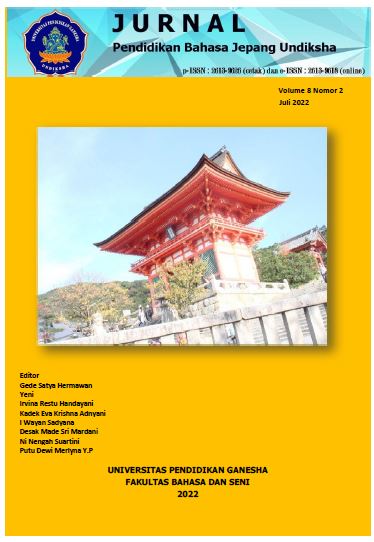ONOMATOPE BENTURAN PADA SHOUNEN MANGA JEPANG DALAM KOMIK KIMETSU NO YAIBA VOL 1-3
DOI:
https://doi.org/10.23887/jpbj.v8i2.43601Keywords:
giongo, impact, Kimetsu no Yaiba, onomatopoeia, shounen mangaAbstract
Onomatopoeia is the designation for sound replicas. The study was intended to describe the characteristics of onomatopoeia and their meanings found in comics. The study focused on onomatopoeia types that showed the sound of inanimate objects, particularly collisions. The thumping group may be grouped into 8, which is 1) blows, shots, and kicks 2) strikes, 3) slaps, 4) slaps, 5) slaps, 6) crashes of objects with hard objects, 7) crashes of objects falling, and 8) objects suddenly collide. Data in this study is the thump taken from the comic kimetsu no yaiba vol 1-3. The theory used in this study is onomatope theory according to Akimoto (2002). Analysis of 51 data shows that there are 7 types of collisions in the comic Kimetsu no Yaiba vol 1-3. Onomatope found in the comic book is primarily 'loud and heavy' and 'sudden occurrences’.
References
Adam J. Moleong, Steven. (1999). Metodologi Penelitian Kualitatif.
Bandung: Remaja Rosdakarya.
Akimoto, Miharu. (2002). Yoku Wakaru Goi. Tokyo: ALC.
Aminuddin. (2015). Semantik: Pengantar Studi Tentang Makna.
Bandung: Sinar Baru Algensido.
Dardjowidjojo, Soedjono. (2003). Psikolinguistik: Pemahaman Bahasa
Manusia. Jakarta: Yayasan Obor Indonesia
Pratiwi, Pradiptia Linggar. (2017). Analisis Penggunaan Onomatope
Yorokobu Dalam Komik Chibi Maruko-Chan. (Skripsi,
Binus University).
http://library.binus.ac.id/Collections/ethesis_detail/2013-1-
-JP (diakses april 2021).
Sahertian. D. C. (2015). Onomatope Suara Berbenturan Dalam
Bahasa Indonesia dan Bahasa Mandari. Daya Literasi dan
Industri Kreatif: Digitalitas Bahasa, Sastra, Budaya,
dan Pembelajarannya.,130-139.
Soepardjo, Djodjok. (2012). Linguistik Jepang. Bintang.
Sudjianto dan Ahmad Dhaidi. (2004). Pengantar Linguistik Bahasa
Jepang. Bekasi: Kesaint Blanc
Yuniarti. A. N. (2018). Analisis Bentuk Fonologis dan Makna
Onomatope Bunyi Glottal Stop. (Skripsi, Universitas
Diponegoro). Diakses dari: Skripsi_Full.pdf (undip.ac.id)
Downloads
Published
Issue
Section
License
Copyright (c) 2022 Jurnal Pendidikan Bahasa Jepang Undiksha

This work is licensed under a Creative Commons Attribution-ShareAlike 4.0 International License.



